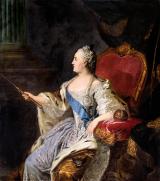Кой излиза с Grigory Orlov?
Екатерина II от Grigory Orlov от ? до ?. Разликата във възрастта беше 5 години, 5 месеца и 15 дни.
Grigory Orlov

Prince Grigory Grigoryevich Orlov (Russian: Григорий Григорьевич Орлов; 17 October 1734 – 24 April 1783) was a favourite of the Empress Catherine the Great of Russia, Prince of the Holy Roman Empire (1772), state and military figure, collector, patron of arts, and General-in-Chief.
He patronised M. V. Lomonosov, D. I. Fonvisin, V. I. Bazhenov and gave them financial support. Honorary member of the Imperial Academy of Arts (since 1765). He collected paintings (including Rembrandt, P. P. Rubens, Titian), sculpture, Chinese, Japanese and Russian porcelain, hunting weapons, etc. (Orlov's collection has been preserved almost completely; it is now in the State Museum-Reserve "Gatchina" of the eponymous city). A large landowner, particularly of the Gatchina manor, where Orlov commissioned the construction of a palace and a landscape garden.
He became a leader of the 1762 coup which overthrew Catherine's husband Peter III of Russia and installed Catherine as empress. For some years he was virtually co-ruler with her, but his repeated infidelities and the enmity of Catherine's other advisers led to his fall from power.
Прочетете повече...Екатерина II

Catherine II (en russe : Екатерина II) ou Catherine la Grande (Екатери́на Вели́кая), née Sophie Frédérique Augusta d'Anhalt-Zerbst le 2 mai 1729 à Stettin en Poméranie (aujourd'hui Szczecin en Pologne) et morte le 17 novembre 1796 à Saint-Pétersbourg, est l'épouse du prince puis empereur Pierre III (1728-1762). Elle devient impératrice régnante de Russie en 1762 jusqu'à sa mort, à la suite d'un coup d'État le 9 juillet 1762, suivi de l'incarcération de Pierre III, puis de son exécution le 17 juillet par un proche de Catherine.
Prénommée Catherine lors de son baptême orthodoxe, nécessaire avant son mariage avec le prince Pierre, elle devient impératrice consort après l'avènement de celui-ci (5 janvier 1762). Après son coup d'État, elle se fait proclamer « impératrice et autocrate de toutes les Russies ».
Elle règne personnellement sur l'Empire russe du 9 juillet 1762 à sa mort le 17 novembre 1796. Sous son règne, la Russie connaît une grande expansion territoriale vers l'ouest et le sud (plus de 500 000 km2), notamment à l'occasion des trois partages de la Pologne (1772, 1793 et 1795) et de guerres victorieuses contre l'Empire ottoman.
Прочетете повече...